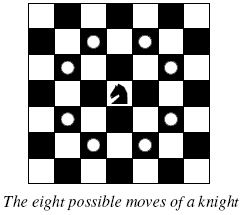Description
 Background
BackgroundThe knight is getting bored of seeing the same black and white squares again and again and has decided to make a journey
around the world. Whenever a knight moves, it is two squares in one direction and one square perpendicular to this. The world of a knight is the chessboard he is living on. Our knight lives on a chessboard that has a smaller area than a regular 8 * 8 board, but it is still rectangular. Can you help this adventurous knight to make travel plans?
Problem
Find a path such that the knight visits every square once. The knight can start and end on any square of the board.
Input
The input begins with a positive integer n in the first line. The following lines contain n test cases. Each test case consists of a single line with two positive integers p and q, such that 1 <= p * q <= 26. This represents a
p * q chessboard, where p describes how many different square numbers 1, . . . , p exist, q describes how many different square letters exist. These are the first q letters of the Latin alphabet: A, . . .
Output
The output for every scenario begins with a line containing "Scenario #i:", where i is the number of the scenario starting at 1. Then print a single line containing the lexicographically first path that visits all squares of the
chessboard with knight moves followed by an empty line. The path should be given on a single line by concatenating the names of the visited squares. Each square name consists of a capital letter followed by a number.
If no such path exist, you should output impossible on a single line.
If no such path exist, you should output impossible on a single line.
Sample Input
3 1 1 2 3 4 3
Sample Output
Scenario #1: A1 Scenario #2: impossible Scenario #3:
A1B3C1A2B4C2A3B1C3A4B2C4
代码:
#include <stdio.h> #include <stdlib.h>
#define MAX 27
int map[MAX][MAX], sx[MAX], sy[MAX];
int dir[8][2] = {{-2, -1}, {-2, 1}, {-1, -2}, {-1, 2},{1, -2}, {1, 2}, {2, -1}, {2, 1}};
int p, q, sign, step;
void dfs(int i, int j)
{
if (sign) return;
int x, y, k;
step++;
sx[step] = i;
sy[step] = j;
if(step == p * q)
{
sign = 1;
return;
}
map[i][j] = 1;
for (k = 0; k < 8; k++)
{
y = j + dir[k][0];
x = i + dir[k][1];
if (map[x][y] == 0 && x > 0 && x <= p && y > 0 && y <= q)
{
dfs(x, y);
step--;
}
}
map[i][j] = 0;
}
int main()
{
int i, j, n, t = 0;
scanf("%d", &n);
while(n--)
{
sign = 0;
step = 0;
t++;
scanf("%d%d", &p, &q);
for (i = 1; i <= p; i++)
{
for(j = 1; j <= q; j++)
{
map[i][j] = 0;
}
}
dfs(1, 1);
printf("Scenario #%d:\n", t);
if (sign)
{
for (i = 1; i <= p * q; i++)
{
printf("%c%d", sy[i] + 64, sx[i]);
}
printf("\n");
}
else
{
printf("impossible\n");
}
if (n != 0) printf("\n");
}
return 0; }
分析:
1、题目要求以"lexicographically"方式输出,也就是字典序...一开始没看懂这个词结果WA了N次...要以字典序输出路径,那么方向数组就要以特殊的顺序排列了...这样只要每次从dfs(1,1)开始搜索,第一个成功遍历的路径一定是以字典序排列...
2、国际象棋的棋盘,横行为字母,表示横行坐标的是y;纵行为数字,表示纵行的坐标是x...一开始又搞反了...
 骑士周游问题求解
骑士周游问题求解




















 2607
2607

 被折叠的 条评论
为什么被折叠?
被折叠的 条评论
为什么被折叠?








